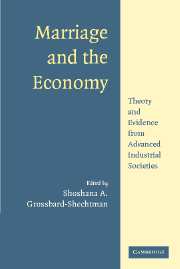Book contents
- Frontmatter
- Contents
- List of Figures
- List of Tables
- List of Contributors
- Foreword
- Acknowledgments
- Marriage and the Economy
- 1 Marriage and the Economy
- PART I THE ECONOMICS OF MARRIAGE AND DIVORCE
- PART II EFFECTS OF MARRIAGE ON INCOME USES
- 5 Control over Money in Marriage
- 6 Marriage, Assets, and Savings
- 7 The Economics of Child Support
- 8 Marriage Prospects and Welfare Use
- PART III EFFECTS OF MARRIAGE ON TIME USES
- PART IV MARRIAGE AND THE MACROECONOMY
- Index
8 - Marriage Prospects and Welfare Use
Published online by Cambridge University Press: 07 December 2009
- Frontmatter
- Contents
- List of Figures
- List of Tables
- List of Contributors
- Foreword
- Acknowledgments
- Marriage and the Economy
- 1 Marriage and the Economy
- PART I THE ECONOMICS OF MARRIAGE AND DIVORCE
- PART II EFFECTS OF MARRIAGE ON INCOME USES
- 5 Control over Money in Marriage
- 6 Marriage, Assets, and Savings
- 7 The Economics of Child Support
- 8 Marriage Prospects and Welfare Use
- PART III EFFECTS OF MARRIAGE ON TIME USES
- PART IV MARRIAGE AND THE MACROECONOMY
- Index
Summary
Over the last few decades, the decline in marriage rates and rise in childbearing among unmarried women have increased the number of women eligible for welfare. The consequent rise in caseloads has increased pressure on welfare programs. In 1996, one-third of unmarried mothers reported receiving Aid for Families with Dependent Children (AFDC), the primary cash welfare program in the United States (U.S. House Committee on Ways and Means, 1998). The AFDC program provided most of its aid to unmarried mothers. The AFDC eligibility criteria were quite restrictive in that aid was allowed to two-parent families only if the primary earner was unemployed or disabled (the AFDC-UP program). The AFDC program has recently been replaced by the Temporary Assistance to Needy Families (TANF). Although TANF has granted states greater leeway in eligibility rules, states have maintained marriage as a key determinant of eligibility, and the welfare caseload largely remains families headed by unmarried women. Since the quality and quantity of potential spouses affect marriage decisions that then interact with welfare use, spouse availability is expected to have an effect on welfare use.
This chapter begins by looking at the links between marriage and welfare use and develops the standard economic model of welfare use based on choice. I then briefly review literature on spouse availability and marriage rates and explore the resulting association between measures of spouse availability and welfare use by looking at crosssectional state data.
- Type
- Chapter
- Information
- Marriage and the EconomyTheory and Evidence from Advanced Industrial Societies, pp. 177 - 198Publisher: Cambridge University PressPrint publication year: 2003
- 1
- Cited by



